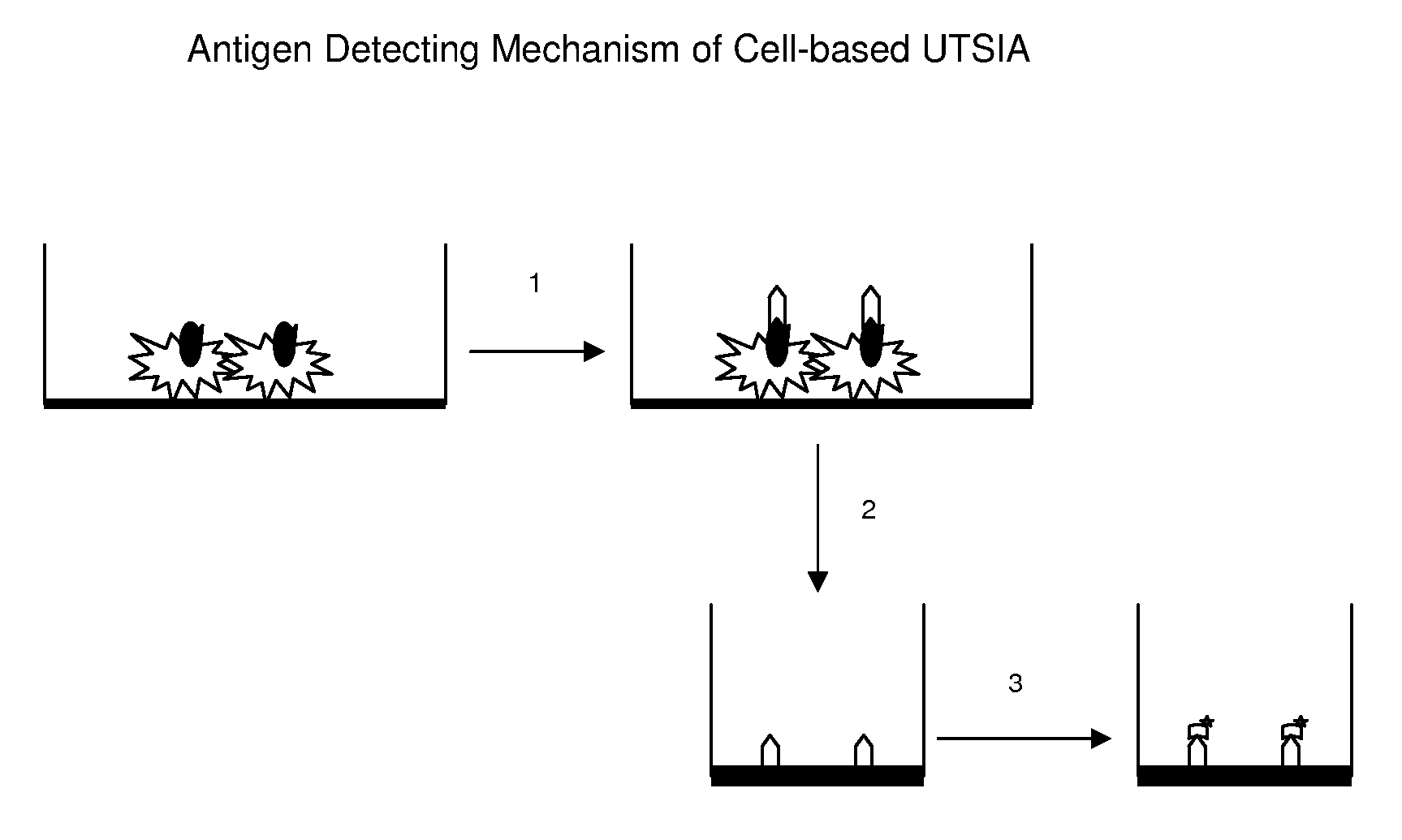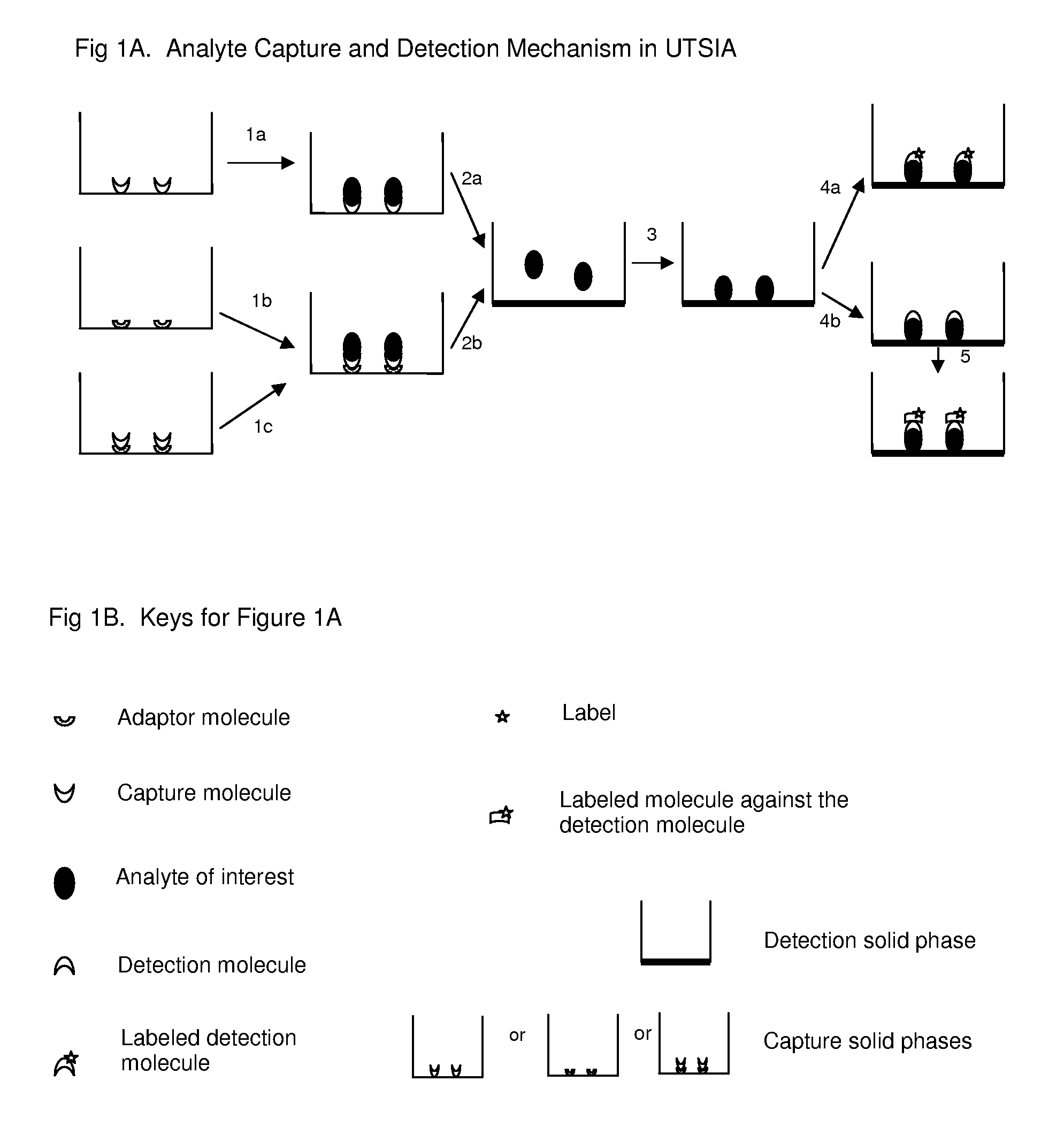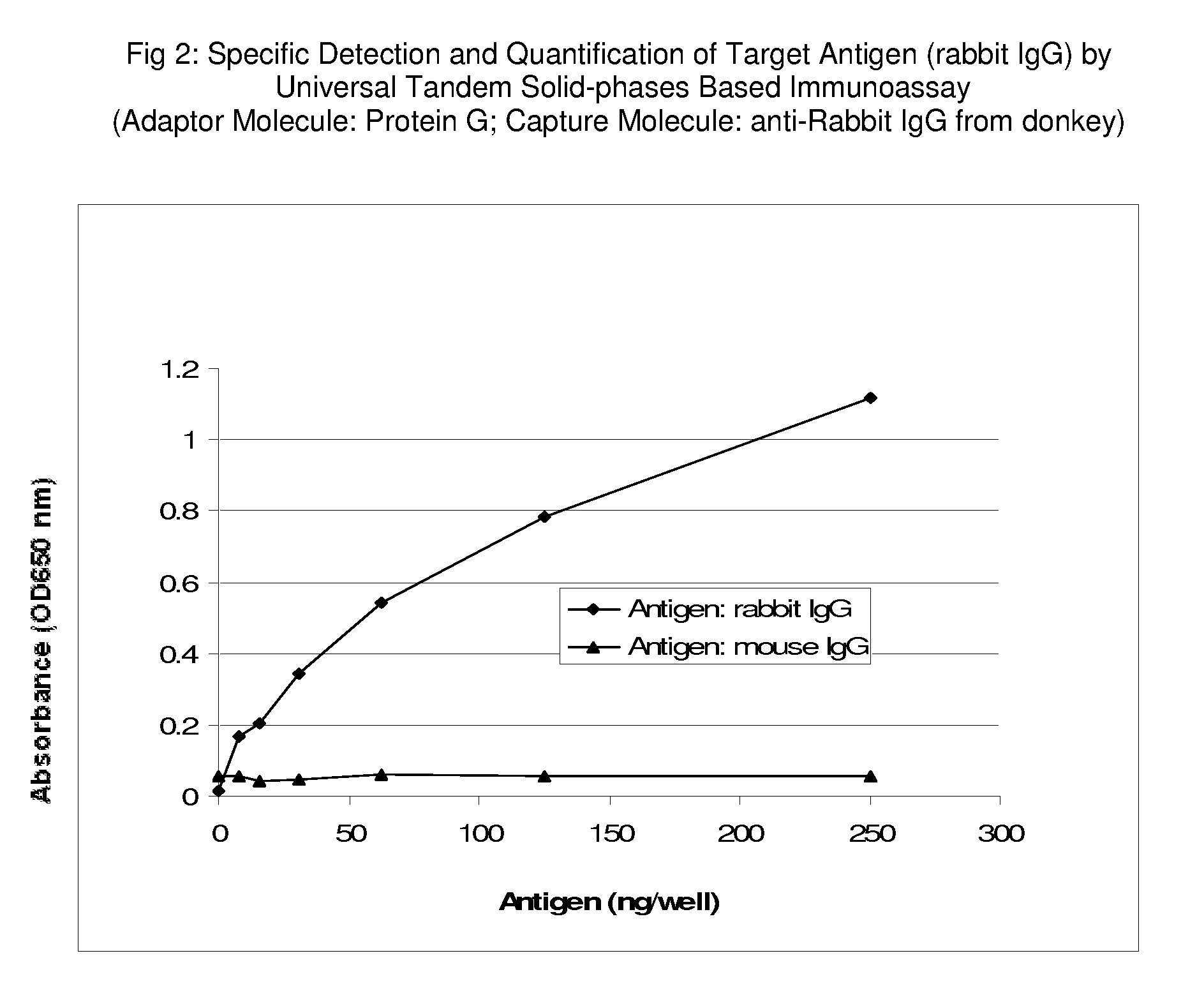[0012]The major goal of current invention of universal tandem solid-phases based immunoassay (UTSIA) is to develop an alternative
protein analyte quantifying method other than sandwich-ELISA with properties of simple, robust, and easier setting up, because practically the sandwich-ELISA is not possible to be set up if there is no a pair of perfect matched
capture antibody and detection antibody available for forming sandwich-like immunocomplex on a solid phase, even though there are many other antibodies commercial available to the analyte of interest.
[0014]This novel while simple immunoassay mechanism of UTSIA provides properties of more flexibility and easier setting up than sandwich-ELISA: 1. there are more antibodies available for acting as
capture antibody, as the adaptor molecule
Protein G on the solid phase prevents the inactivation of the
capture antibody by the solid phase; 2. there are more antibodies available for acting as detection antibody, as the analyte coated on a
polystyrene plate (non-affinity binding solid phase) can be recognized by most of antibodies commercial available if these antibodies are screened and selected by using the analyte coated on a same kind solid phase. The easier setting up of UTSIA is an especially important
advantage as it may take years to develop a sandwich-ELISA for an analyte of interest, while using commercial available antibodies to set up UTSIA may take only days. As UTSIA also can use two antibodies that target on different epitopes of an analyte, the specificity of the UTSIA is equivalent as sandwich-ELISA. The sensitivity of UTSIA, the prototype example of UTSIA demonstrates that the ng level of IgG
protein can be detected in a concentration-
dependent manner, and the sensitivity may be further improved by optimizing the assay
system or combining with high sensitivity detection assay commercially available. In addition, as two
solid phases of UTSIA can be located on a same solid support, such as half of a 96 well
polystyrene plate is affinity binding solid phase, and another half is non-affinity binding solid phase, the assay can be up scaled to
automation assay from manual assay using commercial ELISA
automation robots available.
[0018]Another major inventive step of current invention is figuring out a way to use an adaptor molecule in the affinity binding solid phase to set up a
protein quantitation immunoassay while avoids the modifications of the capture molecule, the detection molecule, the analyte, or other molecules that interacting with adaptor molecule and capture molecule, that the modifications are usually required in the one or two affinity binding solid phases based modified sandwich-ELISA. In UTSIA, an adaptor molecule or adaptor molecules which bind(s) capture molecule in both extreme (such as pH 2.5) and regular pH (such as pH 7.0) could provide the novel assay
system with maximum flexibility to use commercial antibodies as the capture molecule and detection molecule, as the capture molecule on the affinity binding solid phase does not release to the
liquid phase of dissociating buffer, and therefore, does not interfere with the analyte
coating on the solid phase, and does not interfere with the analyte specific determination on the non-affinity binding solid phase by the detection molecule. This inventive step greatly simplifies the burden of setting up assay and reducing the difficulty of setting up assay, and provides the UTSIA with universal property to use any combination of antibodies that from a variety of
animal sources as capture molecule and / or detection molecule.
[0019]One more inventive step of UTSIA needs to mention is that the dissociation process is different in affinity binding solid phase(s) based modified sandwich-
ELISA assay and in non-affinity binding solid phase based UTSIA. For affinity binding solid phase(s) based assay (modified sandwich-ELISA), the analyte dissociated by extreme pH must be neutralized to let the analyte re-binding with original capture molecule, or another capture molecule. But for non-affinity binding solid phase based assay (UTSIA), the analyte dissociated by extreme pH is optional to be neutralized, as even without neutralizing, the analyte still can be coated on the non-affinity solid phase efficiently.
[0022]
Cell-based UTSIA is a modification of UTSIA for determining an analyte that located
on cells or tissue immobilized on a solid phase. The assay comprises releasing a detection antibody bound on the analyte to a
liquid phase by using a dissociation buffer, and then immobilizing the antibody released on a non-affinity binding or affinity binding solid phase for further detecting and quantifying; if the detection antibody is labeled, it can be directly measured; if the detection antibody is unlabeled, it is further determined by a labeled antibody against the detection antibody. One
advantage of the
cell-based UTSIA is that it increases specificity via several mechanisms: it only detect the detection antibody bound by affinity binding (as the detection antibody bound nonspecifically on the cells or tissue can't be released by dissociation buffer), it avoids the non-specific background interference of tissue or cells. Another
advantage is that it does not need
microscopy and image taking and
image analysis, and therefore, it is more simple and less
time consuming, and more robust. The
cell-based UTSIA is especially useful for cell-based
drug discovery in biotech-pharmaceutical industries. It is also useful for cell-based or tissue-based biomarker detection, evaluation, and quantification in basic and clinical medicines, biomedical researches, and other fields. The cell-based UTSIA may also be used in
microarray format for detection of multiple analytes, and can be up-scaled to
automation assay.THE DETAIL DESCRIPTION OF THE INVENTION
 Login to View More
Login to View More  Login to View More
Login to View More 


